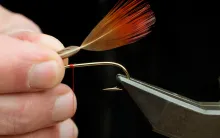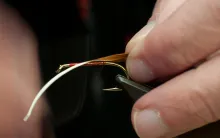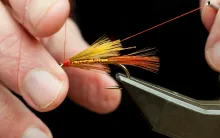I found a 10+ year old fly in a fly box and liked what I saw. The reconstruction of the fly was named the Talisker Touchdown
Why would a fly be called the Talisker Touchdown?
Well, my good friend Mike Hogue suggested Martin's Gold Pheas Ocean Dragon, but I decided against that and named it from the two things that were afoot the night that I rediscovered it: a good single malt whiskey from Skye and the second round of the NFL playoffs.
Found flies
I had found this little gem in a flybox and put it on my desk as I often do with flies.
I have a large cork that I use for flies that are just laying around, and this bugger had been stuck in there for a while. The cork is like a “look at me and do something” signal to myself, a feeble attempt to remind myself that I need to look at the flies stuck in there and decide what to do with them: tie some more, take pictures of them, write articles about them, simply forget them or whatever.
Desk and cork
Now, my desk is a mayhem! My desk is chaos. My desk is the perfect core in a Douglas Adams style Improbability Drive. It's out of control, totally lacks any deeper order and has no underlying pattern or principle.
It's an imperfect mix of my computer, keyboard and monitor, cables, speakers, papers that ought to have been sent to my accountant weeks ago, a cup and a plate from breakfast, magazines and books, my vise and tying tools, lots of materials, scraps, camera gear and a few odds and ends. The only really empty space is where my mouse needs to work, and the rest is edge to edge mess.
Somewhere in this mess there's always flies. Not only the aforementioned cork, but also flies in bags, flies in boxes and... just flies.
Well used and faded
The golden pheasant contraption seen here had been placed in the cork sometime in the autumn when I picked it out of my flybox thinking: “Nice fly! I need to do something with it.”
The fly – yes, the very fly, not the pattern – is at least 10 years old as far as I remember and has been fished several times, which just attests to a couple of things: Kamasan hooks are incredible and some way I'm obviously able to tie a fly that's actually pretty durable.
This one had the signs of usage: slightly dull, tippet in the eye, a bit on the dry and coarse side when touched. But it still looked very fishable, and the hook was nice and sharp. I would have no problem fishing it this day.
Back to the present
That takes me back to the present. The last week or so I have had a camera mounted on my desk and my vise set up for tying, taking pictures and filming video, and that means that a fly found could become a fly photographed in less than a minute. Fly in vise, turn on camera, focus and click. Picture in the box and ready to edit.
That's what I did with the little yellowish fly, and I posted in on Facebook a few minutes later to get some reactions.
A few likes and comments later, I had started this article and had the first suggestion for a name from Mike – which I unthankfully overruled almost instantly inspired by the game running on my second monitor.
Simple and durable
The fly is a classic style Danish sea trout fly: simple, durable and probably very efficient. I have no doubt it will catch, but honestly don't remember if it has. To be truthful, I think it might not, because I have a pretty precise registration of all my catches the latest 10-12 years, and even though I was a little sloppy in the beginning, I'm almost certain that I would have registered and named the pattern if it had been just a little successful when I used it.
Nevertheless I'd be happy to use it now, and I think that merits a materials list and a step by step right there.
Golden pheasant
The fly uses feathers from golden pheasant, and reminds me a bit of the Omoe Brush that I tied using yellow golden pheasant feathers in stead of the red ones used by Ken Bonde in his original. That yellow version of his excellent fly has caught me a lot of fish, and the similarities to that fly again gives this one some credit. I even used to tie the yellow Omoe Brush with a roofed hackle technique rather than wrapping it as on the original Brush, so that fly had a pretty large resemblance with the fly at hand. Another fly, which has some similarities to the Talisker Touchdown is the renown Danish sea trout fly Brenda, which I have tied with yellow GP feathers rather than the tan hen feathers prescribed in the pattern description.
Tying instructions
Click the pictures to see the instructions - use right arrow to navigate through them
|
|
|
|
|
|
|
|
|
|
|
|
|
|
|
|
|
|
|
|
|
|
|
|
|
|
|
|
|
|
|
|
|
|
|
- Log in to post comments












































